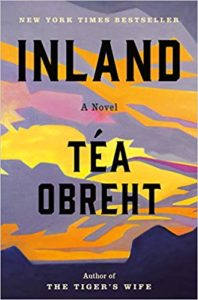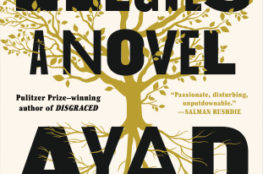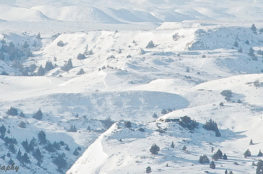Téa Obreht’s new novel is a many layered work of imagination, into which she leads the reader by introducing two powerful characters and a setting so vivid the reader is viscerally drawn into events, even though not able to understand them.
Lurie, a boy of six, immigrates to the United States in the 1850’s with his father, who dies soon after their arrival. In Oliver Twist fashion Lurie survives through crime: first as a pick-pocket, then a grave robber, and finally a highway robber, who falls in with a notorious gang that holds up stagecoaches. After Lurie commits a senseless murder, bounty hunters pursue him, and his life of crime turns into a life on the run.
 In his wanderings Lurie crosses paths with the United States Camel Corp (an actual historic unit of the US army), whose camel drivers were recruited from the nations of the Ottoman Empire. Among them Lurie feels kinship, and traveling with them allows him to take cover under a new identity. In what Lurie describes as a pivotal point in his life, he is given charge of a camel named Burke.
In his wanderings Lurie crosses paths with the United States Camel Corp (an actual historic unit of the US army), whose camel drivers were recruited from the nations of the Ottoman Empire. Among them Lurie feels kinship, and traveling with them allows him to take cover under a new identity. In what Lurie describes as a pivotal point in his life, he is given charge of a camel named Burke.
Obreht’s other main character is Nora, a woman who has followed the man she loves to the frontier town of Amargo (the word for bitter) where he is the newspaperman. Nora homesteads their farm and is the mainstay of the family, providing for her impractical husband, her two rowdy sons, her mute mother-in-law, a daft niece who is given to swoons and séances, and her youngest son who becomes half-blind and inclined to hearing voices and seeing things after he strikes his head in a fall from a horse. The territory in which they live has been stricken by drought, and Nora’s household is close to the end of its reserves of water. She is impatient about small things and uses harsh words with her children, but Nora continues judiciously doling out the precious water drop by drop, taking none for herself. She is desperate and parched.
What these two stories have to do with each other is not obvious at first. Obreht offers them to us in tandem without making the connections clear. Lurie is a wanderer; Nora is a settler. The Arizona territory of Inland where they struggle to survive is not the cowboy country of old movies. There are no heroes or winners in Obreht’s stories. It is a violent and ugly place where death lurks on every side, and survival is random.
We are with Lurie when he slides his skinny boyish arm down into a grave to twist loose from a corpse what he wants to steal. We watch over Nora’s shoulder as she examines the dried up corpse of a young girl who has crawled into the shelter of a cave after suffering sunstroke. We watch wolves feed on the dead and buzzards pick the bones clean. In the purgatorial territory where Lurie is hiding out and Nora is searching for water, these ghoulish events are common, and Obreht’s descriptions of them are brilliant.
These noir adventures have another layer. The stories are riddled with haunts and wandering spirits. Evelyn, Nora’s five month old daughter, dies of sunstroke, but Nora never relinquishes her to death. This gritty woman who is outspokenly cynical about the spiritualism of her niece Josie and chides her son for his belief that their farm is visited by a monster and the ghost of a dead man, preserves for herself the phantom company of her dead daughter. Year by year Evelyn grows up in Nora’s imagination, and their ongoing communication is the soft edge of consolation in Nora’s harsh life of isolation and duty.
Lurie also has haunts. He sees specters of dead children buried along the roadsides of the wagon trail. The corpses he touched while robbing graves haunt him, and the young man he murdered remains with him. Lurie’s boyhood friends, Hobb and Donovan, continue to pass their wants into him, so that Lurie feels compelled to act for them. In Lurie’s world the living and dead are not kept separate.
Among the living Lurie’s closest companion is Burke, his camel. Durable and faithful, Burke becomes the steady ground that moves along under Lurie, the one sure thing from which he knows he must never be parted. Lurie shares his inner thoughts with Burke, and in these dialogues the shattered memories of Lurie’s childhood are gradually reassembled.
Names are important in the two stories of Inland. Lurie recalls that his immigrant father, Hadziosman Djurić, changed his name to Hodgeman Drury because he resented being mistaken for a Turk. When the landlady released his father’s body to the undertaker, the best approximation of his name she could offer was Hodge Lurie. That is the origin of Lurie’s own name. Years later Lurie discovers that his father’s name was Hadji Osman, and that Hadji was the honorific granted after his father made the Hadj to Mecca in fulfillment of his religious obligation as a Muslim. Lurie’s friend, the camel driver Hadji Ali, has endured similar distortions of his name and honor. In America he is called Hi Jolly because his name and its meaning are foreign. With the help of Ali, Lurie is able to recall the place of his birth in Herzegovina, and from that day forward Ali calls him Misafir (sojourner). “We have all been called this or that over the years,” says Ali, “but now we are who we are.”
Given that names are so important, why would Obreht name a camel Burke? He is not a minor character. In fact he is a hero, the steadfast one who plods on and never gives up. He is the one who carries the burdens and endures the trials. Much of Lurie’s story is told in the form of conversations with Burke. Why then the name?
Could Obreht be referencing Edmund Burke, who promoted an aesthetic of the sublime and held that great mysteries, which surpass beauty and are beyond the bounds of reason, are experienced in astonishment? In Nora’s story it is her niece Josie who is most open to astonishment. She calls in conversations with the “other living” (the dead) and bends the limits of time to see back into the hidden past and forward into the unknown future. With regard to everything practical Josie is incompetent, but she is fearlessly open to mystery because “What we see with our hearts is often far truer than what we see with our eyes.”
When at last the two stories that Obreht has been spinning side by side come crashing together, Lurie’s story becomes Nora’s story, and her story completes his. In this too Josie is the medium. Things not seen before can be seen, and things denied are acknowledged. The reader is left standing in the rubble of the stories, seeing for the first time clearly what was in plain sight all along. The reader is also left wondering about things we refuse to see, when like Nora we flee from mystery and hold on to falsehoods because they seem more manageable than the truth.



